This interview was conducted by Mark Worrell for Kronosonic Magazine in May 2005
Kronosonic: Bruce, you just returned from touring Japan. How did it go?
It went really well, thanks for asking. I had a great time! I like Japan very much. The musicians were fantastic, the promoters did a great job and the venues were packed almost every night. The food was delicious. The sake, especially in Niigata, was superb.
This was my second tour there. In December 2003 a wild improv guitarist from Osaka named Bun set up the tour. Drummer Stephen Flinn and I played 15 concerts mostly as a duo but sometimes with musicians from the city we happened to be in. Some of the musicians we performed with in 2003 were: Bun who gets wild sounds from his guitar. He also sings and vocalizes and he does some stuff using a lap top computer. Imagine Butoh meets John Fahey and you’ve got Bun. Katsuyuki Itakura is a pianist that I’ve been doing a lot of work with. He’s been part of the Tokyo creative music scene for over 40 years. Yosio Otani plays alto sax and he’s affiliated with the Onkyo approach that’s been nurtured from OFFSITE; a very cool gallery in Tokyo. I also performed with guitarist Yamamoto Seichi, drummer Toyohito Yoshikawa, guitarist Ueno and Takashi Kojima who uses a laptop.
Kronosonic: Who did you play with this time?
The first performance was at OFFSITE – a gallery in Yoyogi, Tokyo – one of my favorite spots on the tour. I played there with alto saxophonist Yosio Otani and guitarist Tetuzi Akiyama. Yosio set up that show. Yosio and Tetuzi are really cool musicians. They each have a personal sound. I like the scene at OFFSITE a lot.
Most of this tour was with Tokyo pianist Katsuyuki Itakura. Katsu is well known throughout Japan. His level of musicianship is very high – as an improviser, composer and interpreter of standards. Kats organized the other 14 shows on this tour and a recording in Yokohama with vocalist Yuki Saga. Yuki has amazing improv skills. With her 5 octave range and a seemingly endless vocabulary of sounds she keeps you on the edge of your seat. We also performed with a variety of musicians including: cellist Keiki Midorikawa, drummer Shiro Onuma, Dai Souma who plays tenor sax and laptop and drummer Endo Masaaki.
Kronosonic: And how was your reception?
BE: The audiences were great. The people really listen well there.
Kronosonic: Do you think the Japanese are more open to your kind of music than, say, Americans? And, more generally, it must be difficult to find good audiences for your music outside of major metropolitan areas like New York City and some big cities in Europe.
BE: The Japanese listen especially well. There are people all over the world who are open to great new music. They look for it and they appreciate it. There are people all over the world who NEED new music.
Kronosonic: Do you feel somewhat constrained by what might be a limited audience?
BE: No not at all. I don’t think there is a limited audience. The more people who hear this music the more who get energized by it. It’s really a matter of getting cutting edge music played on the radio, talked about in magazines, on TV, at festivals, promoted in a variety of ways. If the major labels chose to promote new, innovative and energetic music perhaps a whole new subculture could be developed that would sustain the highest creative arts for the next generation or two. Not to mention the explosion of imagination coupled with new technology. The music I play allows me to express myself freely and naturally. It’s a process for self-realization. This is what motivates me to maintain the development of my concept level.
Kronosonic: Related to the previous question, how is the internet helping you get your music out into the world and connecting with new fans?
BE: The internet helps musicians to develop a wider audience and participate in a lager pool by connecting with fans and other musicians. I get emails from people all over the world who want to say hello or let me know what they’re up to after hearing my music. The internet is a tool to help develop greater awareness about contemporary expression.
Kronosonic: Early on you chose music as your “24/7” pursuit. Are you able to make a living solely from music or, like most people doing this kind of thing (highly experimental, improvised jazz, if you want to call it that), do you have a day job in a non-music-related field?
BE: I am grateful for all the opportunity I have. I’m fortunate to be involved with music 24/7.
Kronosonic: I see you played in an R&B band in Vegas at one point. I did a “double take” when I read that as I listened to your music. I don’t know many people who can traverse such a gigantic musical distance as this. Was the R&B gig, as well as other “normal” gigs that you’ve had, merely a means of getting by or did you truly love the music?
BE: I love good music. Any style, from anywhere in the world. I grew up with R&B. It’s a lot of fun to play. I listened to AM radio until I was about 10 years old. I really liked soul singers. I still do. When I was a kid I carried a radio everywhere. At that time one would hear Marvin Gaye, Tina Turner, Sly and the Family Stone, Curtis Mayfield, War, Stevie Wonder, Aretha Franklin, Gladys Knight, Booker T and the MG’s, The Isley Brothers, Spinners. All of those bands wrote tunes we loved to sing along with and they had great guitar parts.
Kronosonic: What kind of unconventional techniques have you developed or are using on the guitar?
BE: With music I think the most important thing is the expression of mood, color and emotion as a way to develop self-realization. The guitar is merely a tool to help me achieve these goals. For me the music I’m engaged with – the notes, rhythms, harmonies, melodies, intervals and improvisational concepts – coupled with the right and left hand activities or techniques are all part of one holistic message. I can’t give you a brief answer. Each composition brings forth it’s own requirements.
Kronosonic: Your “polytonal tetra-chordal technique” piqued my curiosity quite a bit because for a couple of years I’ve been working on an idea I call “folding tetra-chords.” Can you tell us more about your approach to tetra-chords?
BE: There are 29 tetrachords and 12 keys for each. It’s pretty easy to develop interesting 8 note scales or scales that have more than 8 notes. Scales that have 1, 2, 3 or more octaves. The average guitar has almost 4 octaves to deal with. Very colorful harmonies can be developed from multiple-octave scales.
Kronosonic: Can you tell us about how you approach prepared guitar?
BE: Cautiously? (with laughter) Seriously, I don’t use a prepared guitar. Really man, I’m the one who has to be prepared. The guitar kicks my ass. For me the guitar doesn’t need to be prepared because it’s already a thing of beauty.
Kronosonic: When I was listening to your tracks I initially thought: “What next? This guy should be heading out into the realms of microtonalism, fretless, synth, and looping. But then I realized that your style is what I might call “ultra foundationalism”, i.e. you’re eschewing effects, distortion, etc. and just stripping your rig down to a guitar, cord, and clean amp and trying to wring every possible ounce of sound and meaning out of a very minimal and, some would say, conventional setup. Why do you choose this route and why do you think it’s important?
BE: It’s what interests me. I go for a sound and I’m interested in producing a good sound that works well with other instruments, most of which are acoustic in nature; drums, acoustic bass, saxophones, trumpets, etc. The paradox is that the electric guitar has something of an acoustic quality. Anyway, with the best equipment I feel that. I’ve been using Mesa Boogie Amps for 20 years. The Mark4 I use has a beautiful 3 dimensional tone. The Mesa Boogie Mark 4 amplifier has a transparent sound, which helps to produce a large 3-D image. The sound is inspiring to deal with. I don’t use any effects, so my guitar is plugged directly into the Mark 4 head, and I use 2 cabinets, one open back, the other closed back with 12” EV’s. The closed back cab provides more bass. The Boogie amps provide a transparent yet warm tone, and I’ve been using them since 1986.
Kronosonic: And the CIMP recording philosophy seems to fall right in line with your playing style and technological choices. It all seems very “earthy” for a lack of a better term. Can you explain this intersection between improvised music and the limits imposed upon that music by the recording and performance technologies?
BE: There’s no microphone that’s as good as your ears man! You only get onto tape what the mic can pick up. Human hearing seems to be sensitive to other qualities of sound; qualities that haven’t been quantified to the point where they can be mechanically reproduced. There’s no limits imposed upon the music I’m involved with. The musicians prefer to record live and together in the same room. Recordings are a document of how we really participate and communicate together. Recording the guitar in a live context is difficult. I want my recordings to have a strong guitar presence so that the subtle nuances of the guitar are heard. We typically do a few soundchecks to find the best mic placement for the guitar and the overall group balance. On OPIUM I used 2 Mesa Boogie cabinets, one closed back, one open back, each elevated and positioned horizontally next to each other in contrast to the vertical stacking of the cabinets for MURAL. The CD’s I’ve recorded are about the battle Music wages for the soul’s transformation amid the din of life. The duality of the existence in the abyss: reality versus fantasy, music versus thought, rules versus emotions, ones imagination and coping with the limits of the body. We triumph by finding the strength to be euphoric. This is the quest for that feeling.
Kronosonic: One thing you said that really interested me was the idea of the physical pleasure derived from playing guitar – insofar as the “right” notes or phrases literally feel good. This would come as a surprise to a lot of technically oriented guitarists who make playing the guitar look like a torture session. And seeing that you play with a set of 18s for guitar strings I can’t imagine that feeling all too good! Tell us more about this if you can.
BE: The tools of course are important. On OPIUM, MURAL, and ASHES I used a 1958 custom shop Fender Stratocaster. The Fender Stratocaster I use has a rock maple neck, which is a dense and resonant wood. I use heavy D’Addario strings: .018P, .022P, .026W, .030, .038, .049. A maple neck is the only thing I’ve seen that will hold up under that tension. The heavy strings produce a fat tone; there is a lot of mass with the vibration. Each composition explores concepts that are unique to that composition and I like it when the music moves on the guitar in a fun way. The combinations of intervals that are used in these compositions are uncommon to jazz guitar and might be unprecedented. For a piece to be well suited for the guitar, tactile concepts are almost as important as acoustic ones. Once I learn the notes, rhythms and accents of a phrase – a phrase I wrote or one I learned from another instrumentalist like Charlie Parker, McCoy Tyner or John Coltrane – I devise fingering’s that are well suited and also fun to play on the guitar. Despite the fact that my fingers may appear to be functioning in a peculiar yogic contortion my own compositions for the guitar fall under the fingers easily. My left hand functions with natural opening and closing movements. A well-formed guitar work produces physical pleasure. The super-fast tempos that I’ve been exploring over the past few years come from an “elementary pulse”. The rhythms that are used are full of energy and charged with accents that provide a strong forward momentum. This goes into the notion of movement. A sense of movement evolves from the pulse. Great movement is like magic – it takes on it’s own life. The music is the manifestation of the magic of the movement. Everybody knows magic when they sense it. You just have to recognize it. The magic lies in giving value to that which is usually despised. Being an ear player I learned guitar by listening to and learning the parts of other guitarists. After a while you realize all of the material that is NOT being explored by guitarists. So I take the forsaken material and give it value. The focus, the concentration, is on vision rather than subject matter. In this way it becomes a search for truth.
Kronosonic: What kind of meanings do you explore with your improvised music that just aren’t open to exploration in other musical forms?
The meaning is in the music itself. When music is good it interacts with emotions.
I approach the guitar in several ways. First off, everything is from the voice. The guitar is an instrument, an extension of my voice. I try to communicate and to interact with all types of activity in life.
Kronosonic: And how do you think it comes across or gets transmitted to an audience? I noticed that you were involving audience members by having them write about color as you played at one show. This, of course, gets into the realm of synesthasia (for example, the color of the number seven or, generally, the synthetic intersection of two or more logically unrelated qualities). Do you suppose that your flavor of improvisation, or maybe free jazz in general, is capable of generating meanings and synesthasic events that are just not possible in less complex musical forms?
BE: I dig it when music is rich with evocative sounds and textures. I enjoy making music with excellent musicians who use forsaken sounds in a creative expressive way. These way new meanings are developed.
Kronosonic: You’ve played with a lot of truly amazing and legendary talents. Who are you dying to play with but haven’t had the chance to?
BE: Good God man what kind of can of worms are you trying to open? (laughter) I’d really like to work with Bjork. Her voice, compositions and production values are amazing.
And there are lots of other musicians that immediately come to mind. In no particular order – McCoy Tyner, Wayne Shorter, Jack DeJohnette, Tony Oxley, Zakir Hussain, Keith Jarrett, John Butcher, Pharoah Sanders, Dave Holland, Dave Douglas, Sam Rivers, Greg Osby, John Zorn, Wynton Marsalis, Matthew Shipp, Buddy Guy, Eric Clapton, Pat Metheny, Barry Guy, Allan Holdsworth, Uri Caine, Anthony Braxton, Sonic Youth, Fred Van Hove, Eminem, Bill Frisell, Ken Vandermark, Toshimaru Nakamura – just to name a few.
Kronosonic: I just about fell out of my chair when I saw that you played in an ensemble called “Little Object A.” Did you or any of the other musicians in the group know the ultra-obscure reference to Lacanian psychodynamic theory (objet petit a)? What was that all about? Was the leader of this group an under-cover Lacanian?
BE: Todd Margasak named that one. He’s a really fine cornetist out of Philadelphia who I’ve been working with for 10 years.
Kronosonic: Are there any guitarists out there that just blow your mind but aren’t on the radar screen (yet)? If you can, point us toward some people that we should be aware of.
BE: Steve Hayden is a guitarist and composer who deserves a lot more attention. His work on the doubleneck Steinberger is unparalled. He’ll have a website up pretty soon. Other guitarists I like are David O’Rourke, David First, Elliot Sharp, Bun, Tetuzi Akiyama and Taku Hannoda. These guys are well known to a lot of people though.
Kronosonic: What’s next for you in 2005 and beyond?
BE: This May I’m doing a 15 city tour of the Mid-West and the South with pianist Katsu Itakura and drummer Brian Osborne. Check my website: www.eisenbeil.com for dates and venues. I’ve recorded a few records that I’m in the process of shopping around. Hopefully each one will be released sooner rather than later. Actually these new recordings will be available at my concerts probably months before they are in the stores.
Kronosonic: Is there anything else you’d like people to know about you or your music that I haven’t touched upon?
BE: Thanks for your interest. The best way to find out more about the music is to come out to the concerts and listen to the cd’s.
Kronosonic: Thanks Bruce!



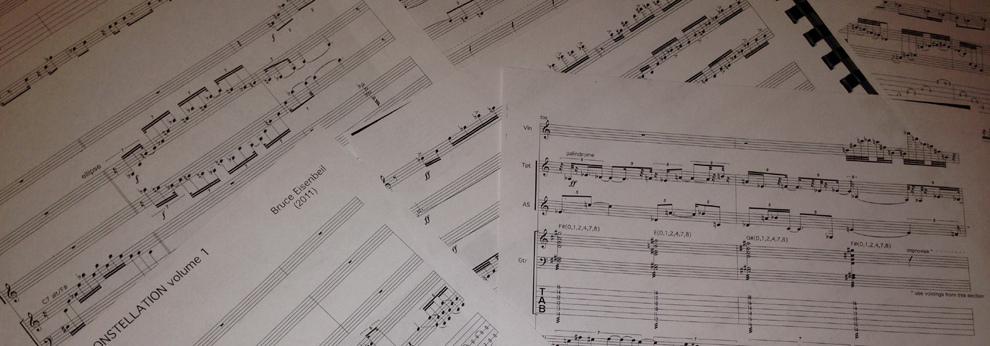

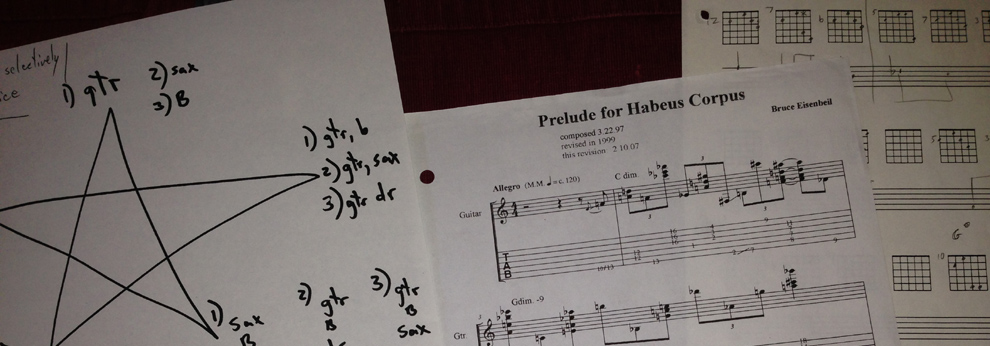
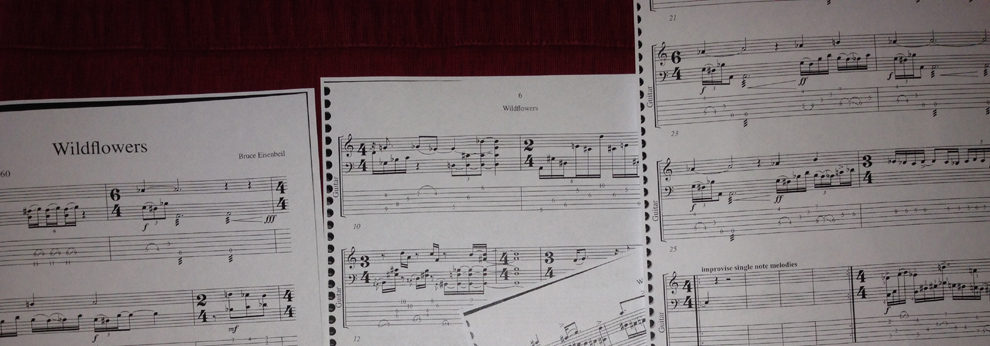








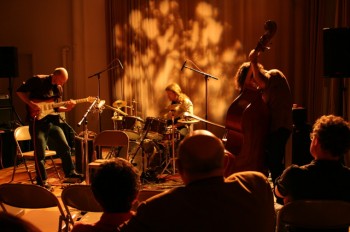
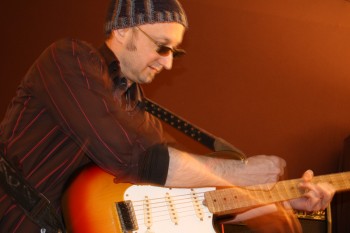
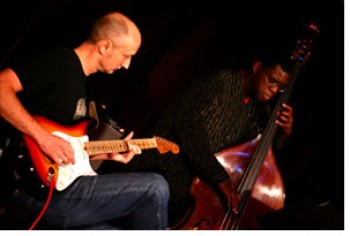
Social Profiles